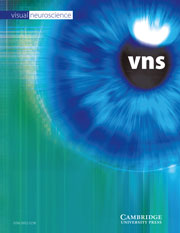Crossref Citations
This article has been cited by the following publications. This list is generated based on data provided by
Crossref.
Hood, Donald C.
Seiple, William
Holopigian, Karen
and
Greenstein, Vivienne
1997.
A comparison of the components of the multifocal and full-field ERGs.
Visual Neuroscience,
Vol. 14,
Issue. 3,
p.
533.
Hood, Donald C.
Holopigian, Karen
Greenstein, Vivienne
Seiple, William
Li, Ju
Sutter, Erich E.
and
Carr, Ronald E.
1998.
Assessment of local retinal function in patients with retinitis pigmentosa using the multi-focal ERG technique.
Vision Research,
Vol. 38,
Issue. 1,
p.
163.
Hood, Donald C.
Greenstein, Vivienne
Frishman, Laura
Holopigian, Karen
Viswanathan, Suresh
Seiple, William
Ahmed, Jameel
and
Robson, John G.
1999.
Identifying inner retinal contributions to the human multifocal ERG.
Vision Research,
Vol. 39,
Issue. 13,
p.
2285.
Hood, D. C.
Frishman, L. J.
Robson, J. G.
Shady, S.
Ahmed, J.
and
Viswanathan, S.
1999.
A Frequency Analysis of the Regional Variation in the Contribution from Action Potentials to the Primate Multifocal ERG.
p.
FD2.
Hood, Donald C
2000.
Assessing retinal function with the multifocal technique.
Progress in Retinal and Eye Research,
Vol. 19,
Issue. 5,
p.
607.
Kondo, Mineo
and
Miyake, Yozo
2000.
Assessment of local cone on- and off-pathway function using multifocal ERG technique.
Documenta Ophthalmologica,
Vol. 100,
Issue. 2-3,
p.
139.
Bearse, Marcus A.
Shimada, Yoshiaki
and
Sutter, Erich E.
2000.
Distribution of oscillatory components in the central retina.
Documenta Ophthalmologica,
Vol. 100,
Issue. 2-3,
p.
185.
Kretschmann, Ulf
Bock, Markus
Gockeln, Roland
and
Zrenner, Eberhart
2000.
Clinical applications of multifocal electroretinography.
Documenta Ophthalmologica,
Vol. 100,
Issue. 2-3,
p.
99.
Tan, Lei
Kondo, Mineo
Sato, Miho
Kondo, Nagako
and
Miyake, Yozo
2001.
Multifocal pupillary light response fields in normal subjects and patients with visual field defects.
Vision Research,
Vol. 41,
Issue. 8,
p.
1073.
Kurtenbach, Anne
and
Weiss, Monika
2002.
Effect of aging on multifocal oscillatory potentials.
Journal of the Optical Society of America A,
Vol. 19,
Issue. 1,
p.
190.
Besch, Dorothea
Kurtenbach, Anne
Apfelstedt-Sylla, Eckart
Sadowski, Bettina
Dennig, Dieter
Asenbauer, Christiane
Zrenner, Eberhart
and
Schiefer, Ulrich
2002.
Visual field constriction and electrophysiological changes associated with vigabatrin.
Documenta Ophthalmologica,
Vol. 104,
Issue. 2,
p.
151.
Onozu, Hiroyuki
and
Yamamoto, Shuichi
2003.
Oscillatory potentials of multifocal electroretinogram in diabetic retinopathy.
Documenta Ophthalmologica,
Vol. 106,
Issue. 3,
p.
327.
Hood, Donald C.
Odel, Jeffrey G.
Chen, Candice S.
and
Winn, Bryan J.
2003.
The Multifocal Electroretinogram.
Journal of Neuro-Ophthalmology,
Vol. 23,
Issue. 3,
p.
225.
KURTENBACH, ANNE
HEINE, JUDITH
and
JÄGLE, HERBERT
2004.
Multifocal electroretinogram in trichromat and dichromat observers under cone isolating conditions.
Visual Neuroscience,
Vol. 21,
Issue. 3,
p.
249.
2005.
Electrophysiology of Vision.
p.
65.
Feigl, B
Brown, B
Lovie-Kitchin, J
and
Swann, P
2005.
Cone- and rod-mediated multifocal electroretinogram in early age-related maculopathy.
Eye,
Vol. 19,
Issue. 4,
p.
431.
Chen, Jennifer C.
Brown, Brian
and
Schmid, Katrina L.
2006.
Evaluation of inner retinal function in myopia using oscillatory potentials of the multifocal electroretinogram.
Vision Research,
Vol. 46,
Issue. 24,
p.
4096.
2006.
Electrodiagnosis of Retinal Diseases.
p.
20.
Hagan, Richard P.
Fisher, Anthony C.
and
Brown, Malcolm C.
2006.
Examination of short binary sequences for mfERG recording.
Documenta Ophthalmologica,
Vol. 113,
Issue. 1,
p.
21.
Jägle, Herbert
Heine, Judith
and
Kurtenbach, Anne
2006.
L:M-cone ratio estimates of the outer and inner retina and its impact on sex differences in ERG amplitudes.
Documenta Ophthalmologica,
Vol. 113,
Issue. 2,
p.
105.

